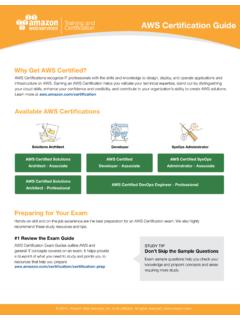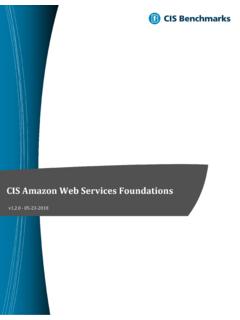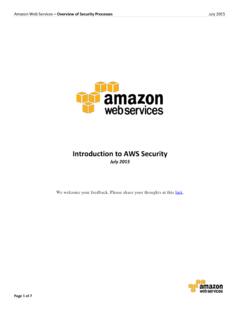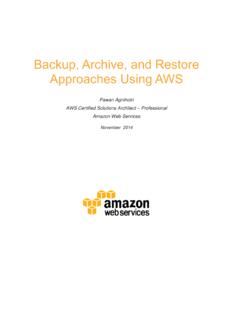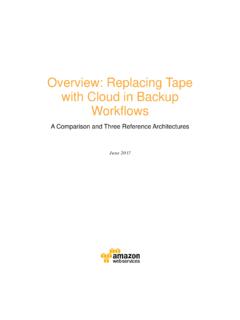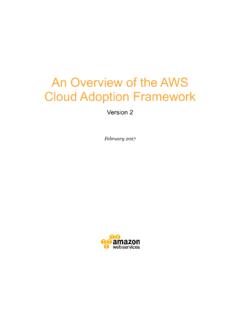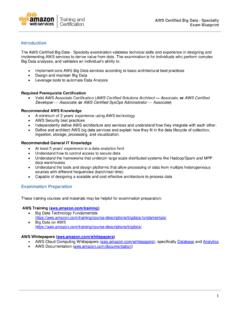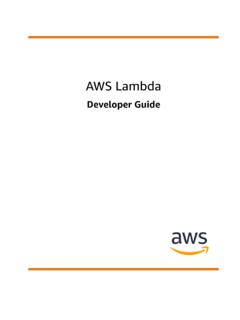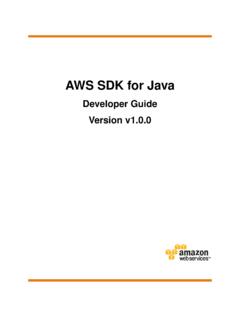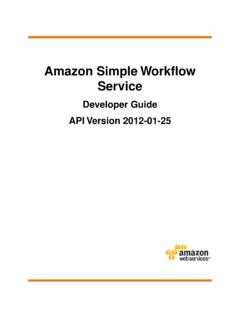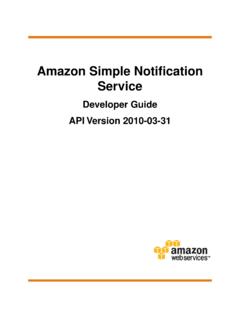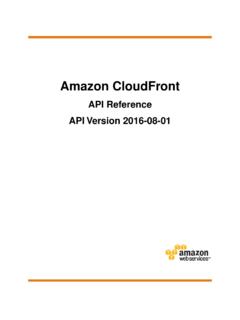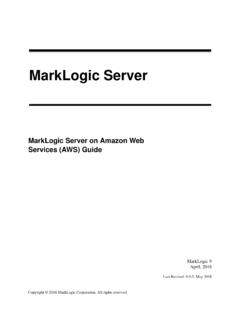Transcription of Microservices on AWS - d0.awsstatic.com
1 Implementing Microservices on AWS June 2019 Notices Customers are responsible for making their own independent assessment of the information in this document. This document: (a) is for informational purposes only, (b) represents current AWS product offerings and practices, which are subject to change without notice, and (c) does not create any commitments or assurances from AWS and its affiliates, suppliers or licensors. AWS products or services are provided as is without warranties, representations, or conditions of any kind, whether express or implied. The responsibilities and liabilities of AWS to its customers are controlled by AWS agreements, and this document is not part of, nor does it modify, any agreement between AWS and its customers. 2019 Amazon Web Services, Inc. or its affiliates.
2 All rights reserved. Contents Abstract .. 4 Introduction .. 1 Simple Microservices Architecture on AWS .. 1 User Interface .. 2 Microservices .. 3 Data Store .. 5 Reducing Operational Complexity .. 6 API Implementation .. 6 Serverless Microservices .. 7 Deploying Lambda-Based Applications .. 9 Distributed Systems Components .. 10 Service Discovery .. 10 Distributed Data Management .. 12 Asynchronous Communication and Lightweight Messaging .. 14 Distributed 19 Chattiness .. 25 Auditing .. 25 28 Contributors .. 29 Document Revisions .. 29 Abstract Microservices are an architectural and organizational approach to software development to speed up deployment cycles, foster innovation and ownership, improve maintainability and scalability of software applications, and scale organizations delivering software and services by using an agile approach that helps teams to work independently from each other.
3 Using a Microservices approach, software is composed of small services that communicate over well-defined APIs that can be deployed independently. These services are owned by small autonomous teams. This agile approach is key to successfully scale your organization. There are three common patterns that we observe when our customers build Microservices : API driven, event driven, and data streaming. In this whitepaper, we introduce all three approaches and summarize the common characteristics of Microservices , discuss the main challenges of building Microservices , and describe how product teams can leverage Amazon Web Services (AWS) to overcome these challenges. Amazon Web Services Implementing Microservices on AWS Page 1 Introduction Microservices architectures are not a completely new approach to software engineering, but rather a combination of various successful and proven concepts such as: Agile software development Service-oriented architectures API-first design Continuous Integration/Continuous Delivery (CI/CD) In many cases, design patterns of the Twelve-Factor App are leveraged for We first describe different aspects of a highly scalable, fault-tolerant Microservices architecture (user interface, Microservices implementation, and data store) and how to build it on AWS leveraging container technologies.
4 We then recommend the AWS services for implementing a typical serverless Microservices architecture in order to reduce operational complexity. Serverless is defined as an operational model by the following tenets: No infrastructure to provision or manage Automatically scaling by unit of consumption Pay for value billing model Built-in availability and fault tolerance Finally, we look at the overall system and discuss the cross-service aspects of a Microservices architecture, such as distributed monitoring and auditing, data consistency, and asynchronous communication. Simple Microservices Architecture on AWS Typical monolithic applications are built using different layers a user interface (UI) layer, a business layer, and a persistence layer. A central idea of a Microservices architecture is to split functionalities into cohesive verticals not by technological layers, but by implementing a specific Amazon Web Services Implementing Microservices on AWS Page 2 domain.
5 Figure 1 depicts a reference architecture for a typical Microservices application on AWS. Figure 1: Typical Microservices application on AWS User Interface Modern web applications often use JavaScript frameworks to implement a single-page application that communicates with a Representational State Transfer (REST) or RESTful API. Static web content can be served using Amazon Simple Storage Service (Amazon S32) and Amazon CloudFront3. Since clients of a microservice are served from the closest edge location and get responses either from a cache or a proxy server with optimized connections to the origin, latencies can be significantly reduced. However, Microservices running close to each other don t benefit from a CDN. In some cases, this approach might actually add additional latency. A best practice is to implement other caching mechanisms to reduce chattiness and minimize latencies.
6 Amazon Web Services Implementing Microservices on AWS Page 3 Microservices We often say that APIs are the front door of Microservices . By that, we mean that APIs serve as the entry point for applications logic behind a set of programmatic interfaces, typically a RESTful web services This API accepts and processes calls from clients and might implement functionality such as traffic management, request filtering, routing, caching, authentication, and authorization. Microservices Implementations AWS has integrated building blocks that support the development of Microservices . Two popular approaches are using AWS Lambda5 and Docker containers with AWS Fargate6. With AWS Lambda, you simply upload your code and let Lambda take care of everything required to run and scale the execution to meet your actual demand curve with high availability.
7 This means, there is no administration of infrastructure needed. Lambda supports several programming languages and can be triggered from other AWS services or be called directly from any web or mobile application. One of the biggest advantages of AWS Lambda is that you can move quickly: you can focus on your business logic because security and scaling are managed by AWS. Lambda s opinionated approach drives the scalable platform. A common approach to reduce operational efforts for deployment is container-based deployment. Container technologies like Docker7 have increased in popularity in the last few years due to benefits like portability, productivity, and efficiency. The learning curve with containers can be steep and you have to think about security fixes for your Docker images and monitoring.
8 Amazon Elastic Container Service (Amazon ECS8) and Amazon Elastic Kubernetes Service (Amazon EKS9) eliminate the need to install, operate, and scale your own cluster management infrastructure. With simple API calls, you can launch and stop Docker-enabled applications, query the complete state of your cluster, and access many familiar features like security groups, Load Balancing, Amazon Elastic Block Store (Amazon EBS10) volumes, and AWS Identity and Access Management (IAM)11 roles. AWS Fargate is a container management service that allows you to run serverless containers so you don t have worry about provisioning, configuring, and scaling clusters of virtual machines to run containers. With Fargate, you no longer have to worry about provisioning enough compute resources for your container applications.
9 Fargate can launch tens of Amazon Web Services Implementing Microservices on AWS Page 4 thousands of containers and easily scale to run your most mission-critical applications. Amazon ECS supports container placement strategies and constraints to customize how Amazon ECS places and terminates tasks. A task placement constraint is a rule that is considered during task placement. You can associate attributes, essentially key-value pairs, to your container instances and then use a constraint to place tasks based on these attributes. For example, you can use constraints to place certain Microservices based on instance type or instance capability, such as GPU-powered instances. Amazon EKS runs the latest version of the open-source Kubernetes software, so you can use all the existing plugins and tooling from the Kubernetes community.
10 Applications running on Amazon EKS are fully compatible with applications running on any standard Kubernetes environment, whether running in on-premises data centers or public clouds. Amazon EKS integrates IAM with Kubernetes, enabling you to register IAM entities with the native authentication system in Kubernetes. There is no need to manually set up credentials for authenticating with the Kubernetes masters. The IAM integration allows you to use IAM to directly authenticate with the master itself as provide fine granular access to the public endpoint of your Kubernetes masters. Docker images used in Amazon ECS and Amazon EKS can be stored in Amazon Elastic Container Registry (Amazon ECR.)12 Amazon ECR eliminates the need to operate and scale the infrastructure required to power your container registry.
